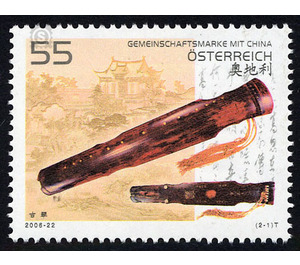Musical instruments - Austria / II. Republic of Austria 2006 - 55 Euro Cent
Theme: Art & Culture
| Country | Austria / II. Republic of Austria |
| Issue Date | 2006 |
| Face Value | 55.00 |
| Edition Issued | 600,000 |
| Printing Type | Photogravure |
| Stamp Type | Commemorative |
| Item Type | Stamp |
| Chronological Issue Number | 1954 |
| Chronological Chapter | OOS-OE2 |
| SID | 232984 |
| In 55 Wishlists | |
For the brand image of the joint edition, the traditional musical instrument was chosen by China: the guqin, a seven-string plucking instrument from the family of zither instruments, which has been played in China for over 3,000 years. It allows a harmonious playing style and symbolizes the true nature of traditional Chinese music. The guqin on the mark, called "Da Sheng Yi Yin Qin," was made during the Tang Dynasty (618-907 AD) and is housed in the Beijing Palace Museum. The instrument is characterized by its sonorous and ancient sound, the elegant design, the simplicity of the painting and the elaborate engraving. The background of the brand is the Guqintai Monument, which is located near the Guishan Mountain in Wuhan City. The monument was built in memory of the story of the meeting of true friends through music. On the walls of the monument is a lifelike relief embedded. His motif depicts the story of "Boya breaking his guqin at parting from his faithful friend" Ziqi, who was, according to tradition, the only person who understood his music. The song "High Mountains and Running Waters" has become synonymous with friendship and the term "One Who Can Understand This Music" has become a term for "faithful friend". In 2003, the Guqin was added to the list of "masterpieces of oral tradition and the spiritual heritage of humanity" by UNESCO. The music - "High Mountains and Running Waters" - was selected as one of the most representative world cultural assets and sent into space with the Universe Exploration Satellite to find true friends of humanity there as well. The text in the background of the stamp is a verse from a song by Song Xiang (1748-1826), a poet from the time of the Quing dynasty.


